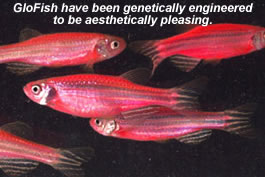
 |
| Home > Policy Issues > Transgenic Fish > Introduction | |||
IntroductionAs the field of genetic engineering advances, we are beginning to see increased commercial application of this technology. Aquatic animals are being engineered to increase aquaculture production, for medical and industrial research, and for ornamental reasons. While some of these alterations may provide some benefits, the potential effects on human health and the environmental risks that transgenic fish pose to native ecosystems remain unstudied and unknown. Some of the same genes inserted to provide benefit for transgenic fish may also contribute to higher risk for other species, including humans. Genes inserted to promote disease resistance may allow transgenic fish to absorb higher levels of toxic substances, including heavy metals.(1) In turn, consumers of these fish may be ingesting higher amounts of substances such as mercury and selenium. Transgenic fish that have genes from species such as peanuts or shellfish that are common causes of allergic reactions in humans may prompt allergic reactions in an unsuspecting consumer. |
|||
|
|||
Currently, there are no federal laws regulating the production, sale, importation and consumption of transgenic fish. The issues surrounding transgenic fish are coming to the forefront as aquaculture companies petition the Food and Drug Administration for approval to sell transgenic fish to the public. The sample bill included in this package addresses these concerns by banning the importation, transportation, possession, spawning, incubation, cultivation, or release of aquatic transgenic animals except under a permit. This web site offers the tools necessary for you to protect your state’s waterways and coasts from transgenic fish, including a legislative summary, talking points, press clips, a fact pack, links, and other background information. We may have other useful materials on this subject, which are not posted on our web site. Please feel free to contact us at [email protected] or call our office in Madison, Wisconsin, at (608) 252-9800. Also see SERC’s package on Genetically Engineered Food. If you’ve used this site and found it helpful or, if you have suggestions about how it could be made more helpful, please let us know. Feel free to use the sample bill text included here in your state. If you do, please notify us. |
|||
| Sources: (1) Hallerman, Eric M. “Genetically Modified Fish and Shellfish: Food for Thought.” Virginia Issues and Answers 8.1 (Winter 2002). Virginia Tech Publications & Outreach Communications. 9 February 2005 <http://www.via.vt.edu/winter02/article2.pdf>. (2) Williams, Rose Marie. “Health Risks and Environmental Issues: ‘Frankenfish’ Await FDA Approval.” Townsend Letter for Doctors and Patients. May 2003. 9 February 2005 <http://www.townsendletter.com/May2003/environissues0503.htm>. |
|||
| This package was last updated on February 11, 2005. |
